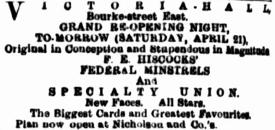Arguably the most popular and influential Australian-based minstrel troupe of the late nineteenth century, the Federal Minstrels were formed by F.E. Hiscocks in April 1883, following his tour of the Australian colonies with the Great Maccabe. The troupe made its debut at Melbourne's Victoria Hall on 21 April, with the feature artists being Charles Heywood (soprano and bird charmer), Sam Dearin (comedian/musician), and Alf Lawton (comedian), along with several other performers and musicians whose careers are now largely associated with both Australia and the Federal Minstrels, namely Lou Braham, Edward Amery, George Turner, and musicians Owen Conduit (piano) and Nicholas La Feuillade (violin/music director). The most influential and certainly the most popular troupe member, however, was W. Horace Bent, who joined the company five weeks into its first season together. While Bent had already built himself a considerable reputation with the Australian public, his popularity soared as a consequence of his association with Hiscocks, not only in response to his celebrated lectures and songs but also through the many original farces, sketches, and burlesques he contributed. The troupe's four-month-long first run not only garnered a good deal of positive criticism from the Melbourne press, but also allowed the principal comedians and ensemble performers (including chorus) to build a rapport with each other. Thus, when Hiscocks transferred the Federal Minstrels to Sydney, its immediate success resulted in that city becoming the troupe's Australian stronghold.
The nucleus of the Federal Minstrels began to establish itself in 1884 with the arrival of three performers who, along with Horace Bent, were regarded by most commentators of the late nineteenth and early twentieth centuries as being unequalled in terms of their popularity with Australian audiences: Beaumont Read, Sam Keenan, and Alf Moynham. This quartet was supported for much of the troupe's career, however, by a number of other leading Australian-based performers of that period, including Thomas H. Rainford, Harry W. Emmet, J. S. Porter, Harry Carroll, J. S. Whitworth, Johnny Cowan, and W. A. Ball, along with founding members Lou Braham and Edward Amery. Indeed, one of the keys to the Federal Minstrel's success may well have been its more or less consistent line-up. Certainly, few other troupes, if any, had remained together in Australia for so long with such a large number of stars and with so few personnel changes.
The Federal Minstrels maintained a constant presence in Australia for six years, making short tours to most major centres (particularly in the eastern states) between long seasons in Melbourne and Sydney. However, in 1889, while they were still unchallenged as the leading local variety minstrel company operating in Australia at the time, Hiscocks disbanded the troupe in order to focus his attention on a higher class of entertainment, initially through the London Pavilion Company. This decision, coming as it did just as the country began to slide more quickly into an economic depression, was very likely the error of judgment (and timing) that hastened his decline as an entrepreneur. Despite the early success of his London Pavilion venture, Hiscocks could not replicate the success he had with the Federals, and soon found himself in financial difficulties when he attempted to try and corner the same small market that Harry Rickards was similarly targeting. Hiscocks attempted to reignite his entrepreneurial career in 1892 and 1894 by putting together at least two new Federal Minstrel troupes (utilising some past performers). However, without the core membership of Bent, Keenan, Read, Moynham, Braham, Amery, Turner, and Porter, the public didn't give Hiscocks the level of support he was hoping for.
 9175655366774854701.jpg
9175655366774854701.jpg